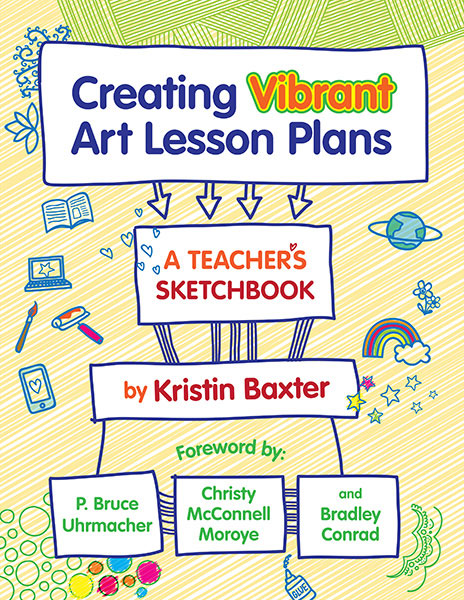Professors: Request an Exam Copy
Print copies available for US orders only. For orders outside the US, see our international distributors.
Foreword by: P. Bruce Uhrmacher, Christy McConnell, Bradley Conrad
Publication Date: April 5, 2019
Pages: 128

Writing lesson plans is often considered busywork, but it can be a useful path for discovering what’s important about artmaking and teaching. This book shows teachers how to slow down, breathe, and linger over the process of unit and lesson plan writing to uncover how much this process can support them professionally, creatively, and personally. The user-friendly text offers guidance for selecting an art project for the unit and then zooms into the nitty-gritty of specific lesson plans, including how to identify materials for a project and how to construct classroom dialogue to help students develop ideas for their artwork. The text also considers standards, assessments, and extensions to other subject areas. Featuring accessible language, clear definitions, practical examples, and self-reflection prompts, this unique resource will help pre- and inservice teachers create lesson plans that are useful to their specific contexts and methods of teaching.
Book Features:
Kristin Baxter is associate professor of art and director of the Art Education Program at Moravian College in Bethlehem, Pennsylvania.
“If you happen to be feeling weary, frustrated, or uninspired, this book sparks imagination, fuels hope, and gives you theories to support what you know needs to be done.”
—From the Foreword by P. Bruce Uhrmacher, Christy McConnell Moroye, and Bradley Conrad, educational researchers
“Baxter invites us to slow down and consider the lesson plan as a creative catalyst to inspire our own artmaking, as well as a space to examine why and what we teach. Written in a clear and accessible manner, this book directly engages readers in a thoughtful conversation about arts education, mindfulness, and the interconnectedness of teachers’ practices of reflection and self-care.”
—Lisa Hochtritt, Maryland Institute College of Art
"An inspiring and playful resource, Kristin Baxter’s new book is much more rewarding than typical lesson planning. Creating Vibrant Art Lesson Plans will surely spark your imagination with every flip of the page.”
— Hailey Adlard, art educator, Parkland School District, PA
Contents
Foreword by P. Bruce Uhrmacher, Christy McConnell Moroye, and Bradley Conrad
Acknowledgments
Introduction
Space to Breathe and Think
What This Book Is Not Meant to Do
What This Book Is Meant to Do
Audience
First Things First
Art Project
Lesson Plan vs. Unit or Unit Plan
Curriculum
Use of Pronouns
Format of This Book
Participatory Features
And More Participatory Features
Outcomes
Reader's Prompts
Writing Invitation
Artmaking Invitation
Self-Care Invitation
Chapter 1. Vibrant Communities: Factors That Influence Our Teaching
Some Background
Community, District, and School or Other Educational Setting
Cultural and Linguistic Contexts
Experiences of Lesbian, Gay, Bisexual, Transgender, Queer, and Questioning Students (LGBTQ+)
Students' Interests Outside of School
Laws: IDEA, Section 504, and ADA
Considering Artistic Development
The Art Program and Facilities
Reader's Prompts
Writing Invitation
Artmaking Invitation
Self-Care Invitation
Chapter 2. Contemporary Art Studio Practices and Artist-Teachers
Some Background
Making Art and Teaching Art
Contemporary Art and Post-Studio Practices
Contemporary Artists
Reader's Prompts
Writing Invitation
Artmaking Invitation
Self-Care Invitation
Chapter 3. The Art Project: Unit Overview
Some Background
Introduction and Students' Prior Knowledge
Expressive Outcomes
Big Idea
Enduring Understandings
Essential Questions
Objectives
Standards and Skills
Safety, Conservation, Sustainability, and Clean Up
Classroom Set Up and Environmental Accommodations
Linking Standards, Skills, Objectives, and Assessments
Reader's Prompts
Writing Invitation
Artmaking Invitation
Self-Care Invitation
Chapter 4. The Art Project: Individual Lessons Within the Unit
Some Background
Lesson Objectives
Materials to Prepare in Advance
Materials for Students
Dialogue, Instructional Activities, and Adaptations
Value of Dialogue
Reader's Prompts
Writing Invitation
Artmaking Invitation
Self-Care Invitation
Chapter 5. Authentic Assessments
Some Background
Domains of Art Education
Science, Technology, Engineering, and Math (STEM)
Interdisciplinary Vocabulary
Family and Community Involvement
Related Museum Visit or Fieldtrip
Curriculum Rationale
Beginnings, Endings, and New Beginnings
Sustenance and Nurturance
Personal Studio Art Practice
Contemporary Art: Opening Up Time and Space for Ideas
Reader's Prompts
Writing Invitation
Artmaking Invitation
Self-Care Invitation
Appendix A: Blank Diagram of a Unit Plan
Appendix B: Questions for Understanding Your Teaching Contexts
Appendix C: Collage Elements for Embellishing This Book and/or Your Unit and Lesson Plans
Appendix D: Sample Outline of a Comprehensive Unit Plan
Appendix E: Sample Unit Plan
Part I: Background About the Community, District, School, Students, Families, and Art Program
Part II: Introduction to the Unit
Part III: Individual Lesson Plans Within the Unit
Part IV: Interdisciplinary Extensions
Glossary
References
Index
About the Author
Professors: Request an Exam Copy
Print copies available for US orders only. For orders outside the US, see our international distributors.